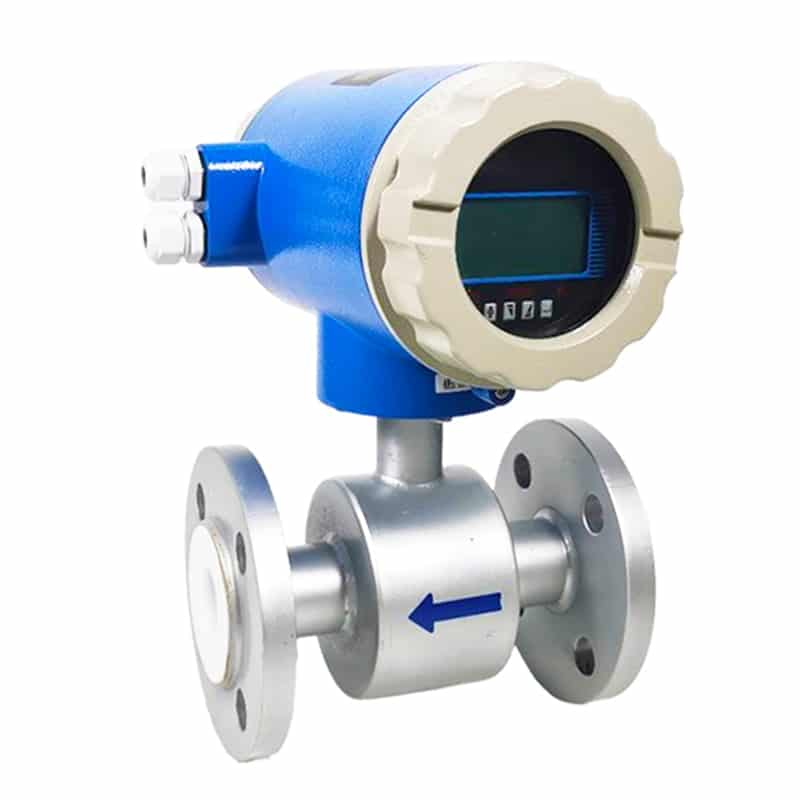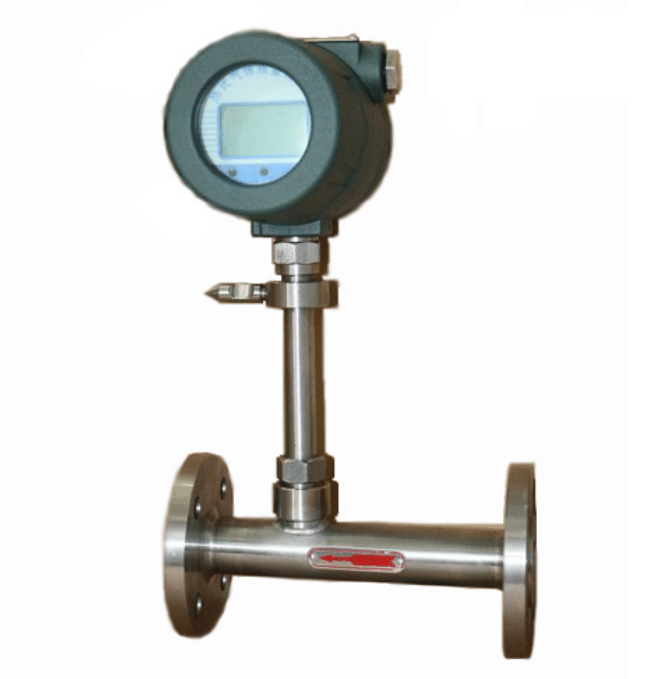As an advanced instrument widely used in the field of flow measurement, the Magnetic Flow Meter (MFM) has become an integral part of many industrial and municipal applications due to its non-invasive nature and high accuracy. However, over time, Magnetic Flow Meters can also face some potential failures and challenges. We will delve into the key issues of magnetic flowmeter troubleshooting to understand the various scenarios that can occur as well as effective strategies to address them.
What is a magnetic flow meter?
A magnetic flow meter is an instrument used to measure the flow rate of conductive liquids. It utilizes the electrically conductive properties in the liquid to measure the flow rate of the liquid fluid by means of an induced magnetic field.
Principle Of Operation Of Magnetic Flow Meters
Magnetic field induction: The main principle of magnetic flow meters is to introduce a magnetic field into a conductive liquid and then measure the electric potential induced in the liquid.
Faraday’s law: According to Faraday’s Law of Electromagnetic Induction, when a conductive liquid passes through a direction perpendicular to a magnetic field, an electric potential is induced in the liquid.
Electrode detection: The magnetic flow meter has two built-in electrodes to detect the induced electromotive force in the liquid.
Measurement of flow rate: By measuring the magnitude of the induced electromotive force, the magnetic flowmeter can calculate the flow rate of the liquid, thus realizing the accurate measurement of the flow rate.


Structure Of The Magnetic Flow Meter
Electromagnet: The part that generates the magnetic field, usually consisting of a coil and a magnet.
Electrodes: Electrodes are used to detect the induced electromotive force in a liquid, usually set in pairs.
Signal processing unit: Used to process and interpret the signals detected by the electrodes and convert them into digital or analog output for the flow rate.
Housing and piping: the external structure that houses the electromagnets, electrodes, and signal processing unit, usually of corrosion-resistant materials to ensure stability and safety during the flow of fluids.
Advantages Of Magnetic Flow Meters
Magnetic flow meters are commonly used in the field of flow measurement for several reasons, including their principle of operation, applicability, and some superior performance characteristics.
- Wide applicability
- High accuracy
- No moving parts
- Unaffected by fluid composition
- Not easily clogged
- High stability
- Low maintenance costs
Types of Magnetic Flowmeters
Magnetic flowmeters can be divided into various types depending on their structure, measurement principle, and application scenarios. The following are some common types of magnetic flow meters:
- Magnetic flow meter: Magnetic flow meter is the most common type and utilizes the principle of electromagnetic induction to measure the flow of conductive liquids. Flow measurement is achieved by introducing a magnetic field into the conductive liquid and measuring the electric potential induced in the liquid.
- ACT Insertion Type Magnetic Flow Meter: ACT Insertion Type Magnetic Flowmeter flowmeter has electrodes that can be inserted into the pipeline and is suitable for piping systems that are already installed. It usually has a smaller measuring diameter and is suitable for some smaller pipe diameter applications.
- Vortex magnetic flowmeter: Combines the characteristics of electromagnetic flowmeter and vortex flowmeter, through the vortex sensor to increase the flow range and reduce the diameter. Typically used in some applications with wide flow ranges.
- Pulse electromagnetic magnetic flowmeter: Use pulse signal output, suitable for applications where flow information needs to be transmitted to other systems or devices.
- Digitized Electromagnetic Flow Meter: With a digital output interface, it can be easily integrated with other digital systems.
Common Magnetic Flow Meter Failures
| Failure Phenomenon | Possible Causes |
| Erratic or fluctuating flow readings | Electrode surface is contaminated or damaged. |
| Air bubbles or impurities in the tubing. | |
| Problems with power supply stability. | |
| Signal line interference. | |
| Zero drift | Electrode is not properly calibrated. |
| Media is present between electrode and fluid. | |
| Electrode surface is corroded or damaged. | |
| Inaccurate measurement range | Uneven or abnormal magnetic field strength. |
| There is an air gap between the electrode and the fluid. | |
| No output signal | Power supply problem, such as low battery or power interruption. |
| Signal line connection failure. | |
| Damaged solenoid or electrode. | |
| Alarm or error message | Faulty solenoid or electrode. |
| Overcurrent or overvoltage condition. | |
| Temperature outside of operating range. | |
| Abnormal substance between the solenoid and fluid. |
How do I troubleshoot a magnetic flow meter?
- Verify measurement conditions and environment: Check for any environmental factors that could cause a malfunction. Ensure that the magnetic flowmeter operates under normal environmental conditions, including the temperature, pressure, and conductivity of the liquid.
- Check power supply and connections: Ensure that the magnetic flowmeter is supplied with a normal power supply and check that the power cord is well connected.
- Check signal wiring: Check the signal wiring to ensure that it is securely connected and not shorted or disconnected.
- Electrode condition: Check the electrode of the magnetic flowmeter, clean the electrode surface, use appropriate cleaning agent if necessary.
- Check the condition of the piping: Check the piping for air bubbles, impurities, or buildup of solid particles.
- Calibrate electrodes: If the magnetic flowmeter allows the user to perform calibration, make sure the electrodes are calibrated correctly.
- Magnetic field condition: Check that the magnetic field generated by the electromagnet is uniform and normal. Abnormal magnetic fields may result in inaccurate measurements.
- Clean the Magnetic Flow Meter: Periodically clean the Magnetic Flow Meter, including the electrodes and the magnetic field sensing section. Clean out possible dirt, deposits, or corrosive materials.
The process of troubleshooting a magnetic flow meter usually involves following certain steps to determine the root cause of the problem and taking appropriate action.
How is traffic monitored?
Magnetic flow meters measure fluid flow by utilizing the conductive properties of electrically conductive liquids. The following are the basic principles of magnetic flow meters for measuring the flow of conductive liquids:
Establishing a Magnetic Field: Electromagnetic flowmeters accomplish this by generating a stable magnetic field around the measuring pipe, usually by using a spiral or solenoid-shaped coil (solenoid). This magnetic field is perpendicular to the direction of liquid flow.
Conductive fluids flow through the magnetic field: When conductive liquids (such as water, acids, bases, etc.) flow through the magnetic field, the charged particles in the liquid (usually ions) will be generated under the action of the magnetic field electric potential. The size of this electric potential is proportional to the fluid flow rate.
Measurement of induced voltage: Electromagnetic flowmeter electrodes are located in the pipe, measuring the induced voltage generated by the liquid. The magnitude of the induced voltage is directly proportional to the flow rate of the fluid, so the flow rate of the fluid can be determined by measuring the induced voltage.
Calibration and Calculation: Because the conductivity of a liquid may be affected by temperature, concentration, and other factors, electromagnetic flowmeters usually need to be calibrated. After calibration, the flow rate of the fluid can be accurately calculated.
It is important to note that electromagnetic flowmeters require a high conductivity of the liquid, as sufficient induced voltage can only be generated when sufficient conductive material is present. In addition, particles and air bubbles in the fluid may also affect the accuracy of the measurement, so additional pre-treatment equipment may be required in special cases.
Summary
In modern industry and municipal engineering, magnetic flow meters have become indispensable flow measurement tools, providing accurate and reliable data support for production and water treatment and other fields. However, in order to maintain its optimal performance, we need to pay close attention to possible malfunctions and take timely and effective measures to solve them.
When faced with complex water quality challenges, Apure stands out for its technological excellence and innovation. With our advanced equipment for water quality analysis, pressure measurement, temperature measurement, and ozone generators, we help our customers monitor, control, and optimize their water treatment processes, contact us for reliable and efficient solutions.
